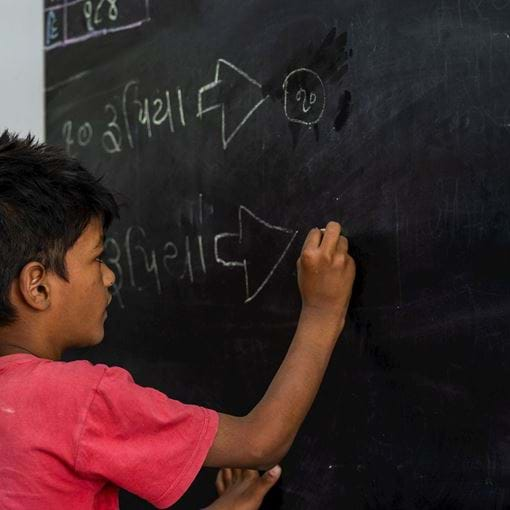LiftEd: From conception to launch – Part 2
On January 24, International Day of Education, we launched LiftEd, our most ambitious social finance project to date, built on the success of programmes like our Quality Education India Development Impact Bond (QEI DIB).
In the first part of this series, we outline how the British Asian Trust developed the idea to launch this initiative to strengthen Foundational Literacy and Numeracy (FLN) in India, sharing our perspective on questions such as ‘Why FLN?’ and ‘Why now?’.
In part two, we want to illustrate how we convened 26 partners across the private sector and civil society to work in alignment with the Government of India’s NIPUN Bharat Mission on FLN in India, and how we designed LiftEd together in the most innovative manner possible, to give us the best shot at turning our vision of impacting 4 million children into a reality.

Collective action, finance, and innovation – building an impact multiplier
After the QEI DIB culminated in 2018 with successful results, we were buzzing with ideas on how to incorporate scale and sustainability into our next education programme, to ensure it went a step further in terms of impact.
A natural starting point was to continue to work with our brilliant partners on the QEI DIB. We set off on a fresh round of exploration with a number of these partners to discuss how we could leverage the momentum created by NIPUN Bharat and build a structured response to support the mission.
As the operating framework for LiftEd began to take shape, we also started connecting with and onboarding new partners in education, all with the vision of convening diverse stakeholders to work towards a shared goal.
Our efforts resulted in a diverse coalition of partners – including the likes of the Michael & Susan Dell Foundation, Bridges Outcomes Partnerships, the Maitri Trust, Reliance Foundation, Atlassian, Standard Chartered Bank, USAID, UBS Optimus Foundation and others – committed to strengthening FLN in India through collective action, finance, and innovation.
While we continued fundraising for the initiative and aligning all partners, the programme’s intricate design began to come together. To achieve maximum impact, LiftEd was designed through a dual approach:
- Development Impact Bond (DIB) to improve in-school learning outcomes: The first DIB where all nonprofit organisations involved are achieving outcomes through a ‘systems change’ approach by working with state governments and public school systems to build their capacity to deliver FLN skills to students. By working with stakeholders who influence education, our systems change approach enables LiftEd to positively impact a larger number of children over a sustained period.
- EdTech Accelerator to improve at-home learning outcomes: The Accelerator supports the development of high-quality, contextually relevant EdTech solutions to improve FLN for children from low-income families. By nurturing these solutions, the Accelerator is filling a critical gap in India’s burgeoning EdTech market, where only ~1% of players focus on FLN, and an even smaller percentage are designing for the bottom of the pyramid.

Both the DIB and the Accelerator are filling critical gaps. Taking a systems change approach to create a ripple effect on students’ learning outcomes in school and unlocking the power of technology to bolster FLN for low-income students at home is a combination that has the potential to improve life chances for millions.
Pushing the envelope – utilising our experience and understanding of the market in India to build for its needs
In designing LiftEd, we have embraced principles and beliefs that are core to our work and part of our DNA:
- Innovation – in our approach to the challenge and our response to it. While the DIB and EdTech Accelerator are both promising interventions in their own right, designing the two instruments to run parallelly has enabled us to build an innovative, comprehensive solution. The dual approach design showcasing how we take a ‘problem first, tool second’ approach by identifying the challenges to solve clearly, and then designing the right combination of solutions that can be used to tackle them.
- Diversity – of stakeholders, forms of capital, and solutions. While we continued to work with a few partners who supported the QEI DIB, we have convened several new partners for LiftEd. Notably, by involving private sector actors, we’re growing our evidence base to demonstrate how CSR can participate in social finance initiatives and achieve higher value for money, as also being demonstrated in our first-of-its-kind Skill Impact Bond.
- Deepening the sector – by adding a systemic lens to our programmes and deploying social finance instruments to achieve outcomes through systems change. This helps us push the envelope on two levels – exploring how social finance can lend itself to ‘indirect’ interventions with a systems change approach (in addition to the more straightforward ‘direct’ delivery of services) and generating much needed data and evidence on the effectiveness of indirect interventions for FLN in the education sector.
As LiftEd progresses through its lifecycle, we look forward to sharing results, learnings, and insights with the education and innovative finance sectors, to help disseminate what works and what doesn’t in FLN and highlight how social finance can bring a critical ‘value add’ to these interventions.
This is the first half of our two-part series on LiftEd. Read part one here.
If you’d like to stay updated on LiftEd’s journey and get the latest insights, results, and learnings from the programme, please sign up on our website www.liftedindia.com.
